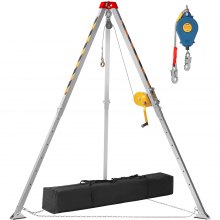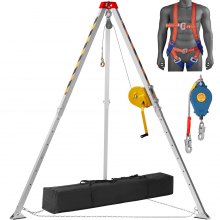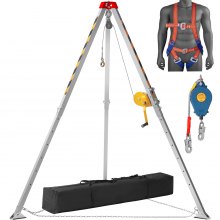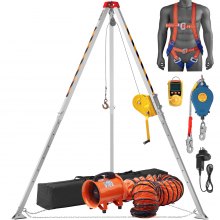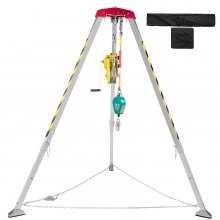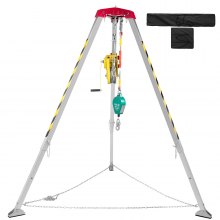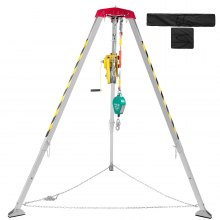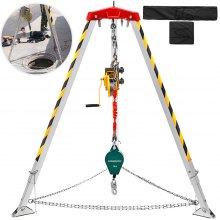VEVOR Exploring the Role of Rescue Tripods in High-Risk Rescues
The rescue tripod concept is recognized in light of the fundamental need for stability and support in mild situations. Whether it’s a collapsed building, limited space, or treacherous terrain, survival issues often present daunting challenges that require innovative solutions. Then, the rescue tripod emerges as a beacon of reliability, providing a stable platform for vertical access, extraction, and recovery—a lifeline for the injured and rescuers.
At the heart of its efficiency is structural integrity and load-carrying capacity. Constructed and precision-made from durable materials such as aluminum or steel, the rescue tripod is designed to withstand high pressures and provide a safe place to install where traditional systems fail.
Benefits of Rescue Tripods
Tripod rescue is an invaluable tool in emergency response situations and provides various benefits that enhance rescue operations' safety, efficiency, and effectiveness. Here are some of the main advantages of a rescue rig.
Safe Vertical Descent
Tripod rescue descents facilitate controlled descents into confined spaces or hazardous areas, reducing the risks associated with free falls or uncontrolled landings Time equipped with specialized rigging and landing systems, these tripods can accurately and reliably guide responders over vertical obstacles, providing rescuers and victims securely established.
Rapid Deployment
Time is often of the essence in rescue operations, where every second can mean the difference between life and death. Rescue tripods are designed for quick deployment, with quick-release mechanisms, lightweight materials, and flexible assembly techniques that reduce set-up time and improve efficiency. This quick assembly ensures an early or late response. They can begin rescue efforts without delay.
Enhanced Access and Extraction
Providing a sturdy platform for vertical entry and evacuation, tripod rescue devices spread out responders, allowing them to reach areas that would otherwise be inaccessible or unsafe. Whether rescuing or evacuating casualties from confined spaces, landing equipment at a disaster site, or lifting casualties to safety, tripod rescue facilitates easy entry and removal.
Essential Accessories For Rescue Tripods
There are several accessories that responders can incorporate into their rescue operations to be more effective and safer. These include:
Rescue Harnesses and Personal Protective Equipment (PPE)
Lifelines are critical to the safety of responders and victims during vertical descents, ascents, or evacuations. Harnesses must be fitted with attachment points that match the tripod's rigging plan to ensure safe anchorage and fall protection.
In addition, personal protective equipment (PPE) such as helmets, gloves, safety goggles, and appropriate footwear are essential to protect responders during rescue operations.
Lifting and Rigging Gear
Another essential accessory to have is the necessary lifting and rigging gears. These include carabiners, shackles, slings, and mechanical advantage systems. They enhance the rigging operations and create configurations suitable for different rescue needs.
Medical and First Aid Equipment
Medical first aid responders are readily available alongside the rescue tripod for immediate care of casualties in medical emergencies or mass casualties. This may include trauma equipment, stretchers, cradle collars, and basic life support equipment, allowing responders to stabilize patients and begin treatment while awaiting further medical assistance or evacuation.
Safe Deployment Procedures For Rescue Tripods
Safe procedures for rescue tripods are essential to ensure the welfare of rescuers and victims during emergency operations. Proper planning, preparation, and execution are essential to minimizing risks and achieving successful results.
Risk Assessment and Site Evaluation
Conduct a comprehensive risk assessment of the reception area to identify uneven buildings, confined spaces, hazardous materials, environmental hazards, or potential hazards. Inspect terrain and access roads there and in the surroundings, check for tripod suitability, and arrange any necessary adjustments or precautions.
Equipment Inspection and Preparation
Inspect all parts of the rescue tripod, including legs, head assembly, rigging areas, pulleys, and safety devices, to ensure they are in good working condition and free from damage or defects. Before use, verify the integrity of cables, cables, personal protective equipment (PPE), and accessories, such as pulleys, carabiners, rigging hardware, etc.
Assemble and set up tripods according to the manufacturer’s instructions and performance requirements, ensuring proper alignment, stability, and load-bearing capacity.
Rigging and Attachment
Secure the tripod with appropriate cables, pulleys, and rigging systems, ensuring alignment and sufficient rigidity to distribute weight evenly and reduce friction or entanglement. Attach life harnesses or individual fall protection systems to anchor points indicated on the tripod and ensure that all communications are secure and appropriate for any rescue or victim.
Why Choose VEVOR Rescue Tripods?
When considering a rescue tripod, VEVOR stands out as a reliable choice because of several key features that differentiate their products on the market.
VEVOR is known for its commitment to quality and sustainability in manufacturing. Strict quality control procedures are used throughout the process to maintain consistency and reliability in every tripod manufactured.
Safety is paramount in rescue operations. VEVOR's rescue tripods are engineered with a wide range of safety features to protect rescuers and victims; this includes an integrated fall protection system, load control monitoring devices, redundant emergency stop devices, and docking areas.
Time is often of the essence in rescue operations, and VEVOR’s rescue tripods are designed for rapid deployment and assembly. With a proven reliability and performance track record, VEVOR's tripod rescue systems are used by emergency response companies, fire departments, search and rescue teams, and industrial safety personnel who rely worldwide on them.
FAQs About Rescue Tripods
Are rescue tripods suitable for training and preparedness exercises?
Tripod rescue devices are a valuable training tool for emergency response teams and rescue workers. Training exercises, including simulated rescue scenarios, mock rescues, and skills drills, will familiarize responders with tripod techniques, rigging procedures, and rescue plans in a scenario in which they have been controlled.
How are rescue tripods deployed and assembled?
The tripod rescue is deployed with extended adjustable legs on firm ground or mooring areas. The tripod head assembly is attached and fitted to rigging systems, pulleys, and safety harnesses if required. Proper assembly and handling techniques are essential to ensure tripod stability and effectiveness during rescue operations.
What materials are rescue tripods typically made of?
Rescue tripods are typically made of high-strength materials such as aluminum or steel. They remain lightweight and portable, easily deployed in an emergency, making them strong and durable.




























